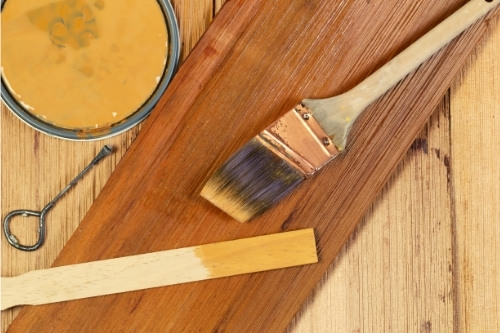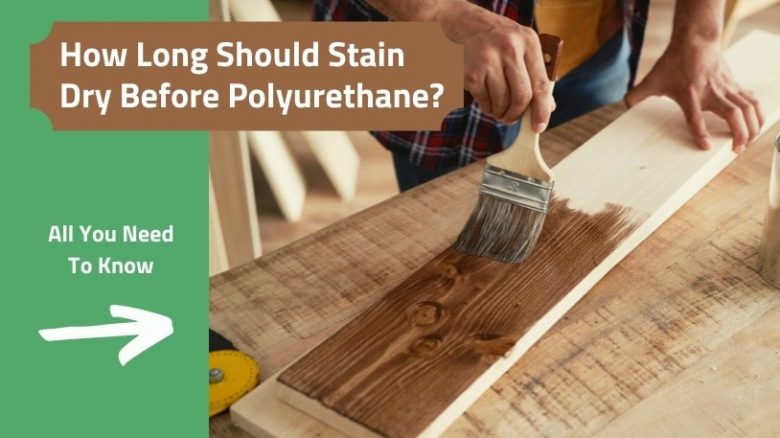Knowing how long to let a wood stain dry before applying a polyurethane topcoat is complicated by the wide selection of water and oil-based stains and polyurethanes on the market today. If the stain isn’t correctly cured, the polyurethane will wipe off the stain or not adhere well. You waste time and money while messing up your project if you get it wrong.
I haven’t had many coating failures in my woodworking career, but impatience is the main reason behind those that have occurred. When dealing with paints and stains, being in a hurry will not get you the quality of finish you desire, and end up taking twice as long.
We’re going to step through the points you need to know about applying polyurethane over a wood stain to ensure you achieve the result you deserve.
How long to let a stain dry before applying polyurethane?
Most manufacturers recommend allowing 12 to 24-hours before applying a topcoat to the stain. However, you can get away with four to six hours in some circumstances. The stain must be completely dry, yet, this drying time can vary due to the type of stain used, the temperature and humidity at the project location, and whether it’s indoors or outdoors.
How long does stain take to dry?
There are four terms manufacturers use when discussing drying time. These are touch dry, hard dry (or recoat), topcoat, and full cure times, and all are quoted at a standard temperature and humidity. The usual standard temperature used is between 70 and 80 degrees Fahrenheit or 21 to 27 degrees celsius. The standard humidity is normally 50%.
The coating industry defines the touch dry state as when small glass spheres can be lightly brushed off the coating without damage. For us, that means you can lightly touch the surface without a transfer of color to your skin and without leaving a mark on the surface. However, apply pressure in this state, and you’ll damage the surface as the underlying coating is still wet.
The hard dry, or recoat state, is when the coating is dry throughout its thickness. At the hard dry stage, you can apply a further coat of the product if you wish. You can apply pressure to the coating, even carefully walk on it, although too much pressure or scuffing and you will mark the surface.
Topcoat refers to a covering hard enough to apply a different coating, such as applying polyurethane over a stain. Finally, full cure is when the coating has reached its full chemical and mechanical properties specified in the material specification or product data-sheet.
While all manufacturer’s recommendations vary, most stains will be touch dry in one to two hours, with a recoat possible within two to four hours. After eight hours, you can apply topcoats such as polyurethane, and a full cure can take anything from three days to a month. However, there are important caveats to this rule-of-thumb, and wide discrepancies in drying time, so read on to understand these.

How long to let water-based stain dry before applying polyurethane?
Answer: At least 4 hours.
Water-based stains are fairly new to woodworking, and they are popular due to an easier clean-up, less smell, and a quicker drying time. They soak into the wood, much like an oil-based stain, but their drying time is quicker. Expect one to two hours before they are hard dry. Some woodworkers get away with applying a polyurethane topcoat at this point.
You should only apply polyurethane to wood at around 12% moisture content, and you’ve just applied a water-based stain, which has soaked into the timber. Unless you’re in a hot climate, I doubt the wood will be back to 12% moisture content within one to two hours. I’d strongly advise holding off for at least four hours.
Give your project a fighting chance; the polyurethane may look great when you put it on, but you can find the adhesion is poor, which will only show itself in days or months to come.
How long to let oil-based stain dry before applying polyurethane?
Answer: At least 8 hours.
Oil-based stains are a thicker consistency than water-based ones, and they take longer to soak into the wood and longer to dry. Most manufacturers quote anything from six to 24-hours for the oil-based stain to be hard-dry.
Once again, you might get away with six hours, but if you want longevity from your polyurethane finish, give it a minimum of eight hours. I usually wait overnight and apply the polyurethane the next day. If you’re in a cold or humid climate, oil-based stains might not be dry enough to receive polyurethane topcoats for two to three days.
Learn More: Water and Oil-Based Polyurethane Differences
How long to let gel-based stain dry before applying polyurethane?
Answer: At least 24 hours.
Gel-based stains are a different beast again from water and oil-based. Unlike its contemporaries, a gel-based stain doesn’t penetrate the wood; rather, it stays on the surface much like paint. It’s also quite a thick consistency and, therefore, can take anywhere between eight and 24-hours to hard dry.
If you apply oil-based polyurethane too quickly to a gel-based stain, you’ll end up wiping off the gel stain in patches, giving your project a blotchy finish. I’d wait for a minimum of 24-hours before applying polyurethane over a gel-based stain.
Further Reading: How to Apply Polyurethane to Wood?
Does being indoors or outdoors matter?
Yes, it does. Our indoor climate is usually controlled with fairly constant humidity and temperature that suits our physiology. Outdoors, the climate varies dramatically through the day and night, with large temperature and humidity fluctuation.
Always allow a lot longer for the stain to dry if you’ve applied it in an outdoors setting. Unless you live in a desert with constant low humidity and high temperatures, you can easily double the drying time for stains when they’re used outdoors.
F.A.Qs
How do you know when the stain is dry?
Water-based stain will be dry to the touch, although I’d check the moisture content of the timber to be sure. An oil-based stain will stop smelling as much, and the surface is no longer tacky when touched. A gel-based stain should resist scratching with your fingernail (in an inconspicuous spot) and is no longer tacky.
What happens if you apply polyurethane before the stain is dry?
Two effects can occur. Either the polyurethane doesn’t dry properly, or it does dry but has poor adhesion in places, and the surface will flake off over time.
What to do if you applied polyurethane before the stain has dried?
You only have one choice. You must remove the polyurethane, resand the surface of your project, reapply the stain, and then apply the polyurethane once the stain is dry. Trying to save an hour or two, in the beginning, will give you days of rework in the end.
Learn More: How To Fix Polyurethane Mistakes

